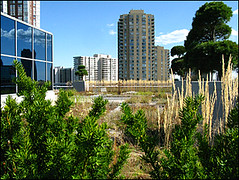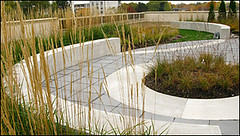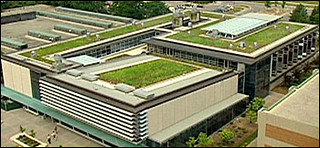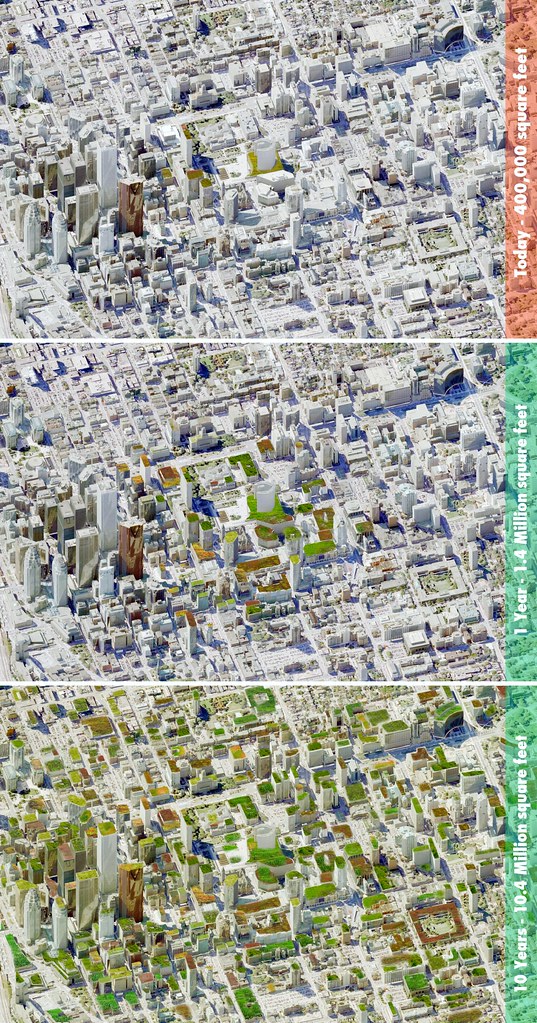Toronto's leadership for green roofs

Posted April 25, 2012 at 1:59PM
In January of 2010, Toronto became the first city in North America to require the installation of green roofs on new commercial, institutional, and multifamily residential developments across the city. Next week, the requirement will expand to apply to new industrial development as well.
Simply put, a “green roof” is a rooftop that is vegetated. Green roofs produce multiple environmental benefits by reducing the urban heat island effect and associated energy demand, absorbing rainwater before it becomes runoff, improving air quality, and bringing nature and natural diversity into urban environments. In many cases, green roofs can also be enjoyed by the public much as a park can be.
 Toronto’s requirements are embodied in a municipal bylaw that includes standards for when a green roof is required and what elements are required in the design. Generally speaking, smaller residential and commercial buildings (such as apartment buildings less than six stories tall) are exempt; from there, the larger the building, the larger the vegetated portion of the roof must be. For the largest buildings, 60 percent of available space on the roof must be vegetated.
Toronto’s requirements are embodied in a municipal bylaw that includes standards for when a green roof is required and what elements are required in the design. Generally speaking, smaller residential and commercial buildings (such as apartment buildings less than six stories tall) are exempt; from there, the larger the building, the larger the vegetated portion of the roof must be. For the largest buildings, 60 percent of available space on the roof must be vegetated.
For industrial buildings, the requirements are not as demanding. The bylaw will require that 10 percent of available roof space on new industrial buildings be covered, unless the building uses “cool roofing materials” for 100 percent of available roof space and has stormwater retention measures sufficient to capture 50 percent of annual rainfall (or the first five mm from each rainfall) on site. For all buildings, variances to compliance (for example, covering a lesser roof area with vegetation) may be requested if accompanied by fees (keyed to building size) that are invested in incentives for green roof development among existing building owners. Variances must be granted by the City Council.
The industry association Green Roofs for Healthy Cities announced last fall in a press release that Toronto’s green roof requirements had already resulted in more than 1.2 million square feet (113,300 square meters) of new green space planned on commercial, institutional, and multifamily residential developments in the city. According to the association, the benefits will include more than 125 full-time jobs related to the manufacture, design, installation and maintenance of the roofs; reduction of more than 435,000 cubic feet of stormwater (enough to fill about 50 Olympic-size swimming pools) each year; and annual energy savings of over 1.5 million KWH for building owners. The longer the program is in effect, the more the benefits will increase.
The triptych image above was developed by students at the University of Toronto to illustrate changes that could ensue from ten years of progress under the city’s requirements. Prior to the bylaw, Toronto was second among North American cities (after Chicago) in its total amount of green roof coverage. Other images accompanying this post (move your cursor over them for details) show green roofs on various Toronto buildings, including a publicly accessible showcase project on the City Hall’s podium.
Related posts:
- Transforming a derelict city building into vertical gardens for nearby residents (February 20, 2012)
- Can Ontario deliver the continent's best land-use plan? (January 26, 2012)
- DC charity develops large rooftop garden to serve the city (April 20, 2011)
Move your cursor over the images for credit information.



